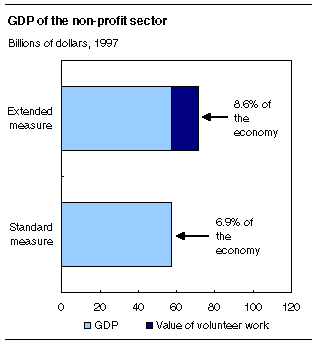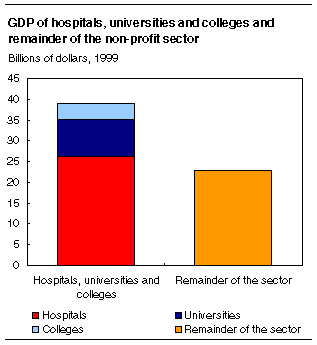Not for profit: waiting for the social economy
Oct 16th, 2004 | By L. Frank Bunting | Category: Key Current Issues One of the quieter but potentially more interesting parts of the recent federal throne speech in Canada alludes to “the social economy–the myriad not-for-profit activities and enterprises that harness civic and entrepreneurial energies for community benefit.”
One of the quieter but potentially more interesting parts of the recent federal throne speech in Canada alludes to “the social economy–the myriad not-for-profit activities and enterprises that harness civic and entrepreneurial energies for community benefit.”
Paul Martin’s government argues that these enterprises can make the country’s “Cities and Communities” stronger. To help “create the conditions for their success, including the business environment within which they work,” it will be introducing “a new Not-for-Profit Corporations Act.”
 As a sign that throne speech writers still have influence in the Ottawa bureaucracy, the Statistics Canada Daily for September 20, 2004 had already had already reported on a “National Survey of Non-Profit and Voluntary Organizations, 2003.” The same issue offered further details on “Non-profit institutions and volunteering: Economic contribution, 1997 to 1999.”
As a sign that throne speech writers still have influence in the Ottawa bureaucracy, the Statistics Canada Daily for September 20, 2004 had already had already reported on a “National Survey of Non-Profit and Voluntary Organizations, 2003.” The same issue offered further details on “Non-profit institutions and volunteering: Economic contribution, 1997 to 1999.”
Yet nicely crafted political speeches on “voluntary organizations and social economy enterprises that are finding local solutions to local problems” may only seem like innovative strategic action on important areas of current policy concern. When you start digging into the Statistics Canada numbers, talk of this sort can quickly turn murky.
Hospitals and universities are the not-for-profit heavyweights
 In 2003 “about 161,000 non-profit and voluntary organizations were operating across the country in a wide variety of areas.” Just over one-fifth of these organizations dealt with some aspect of “Sports and recreation,” and just under another one-fifth with “Religion.”
In 2003 “about 161,000 non-profit and voluntary organizations were operating across the country in a wide variety of areas.” Just over one-fifth of these organizations dealt with some aspect of “Sports and recreation,” and just under another one-fifth with “Religion.”
This seems to fit a reassuringly traditional pattern. But the next two largest numbers of organizations in 2003 were in “Social services” (11.8%) and “Grant-making, fundraising, and voluntarism promotion” (9.9%) – newer realms with more confusing post-modern overtones.
 The traditional pattern returns with such groups as “Arts and culture” (8.5%), “Education and research” (5.1%), “Law, advocacy and politics” (2.3%), and “International” (0.6%). The two sub-sectors at the very bottom of this particular list, however, point to something different again.
The traditional pattern returns with such groups as “Arts and culture” (8.5%), “Education and research” (5.1%), “Law, advocacy and politics” (2.3%), and “International” (0.6%). The two sub-sectors at the very bottom of this particular list, however, point to something different again.
In 2003 “Hospitals” accounted for only 0.5% of all about 161,000 not-for-profit organizations, and “Universities and colleges” a mere 0.3%. But when you turn to the statistics on Economic contribution: “Hospitals (including residential care facilities), universities and colleges accounted for the lion’s share of non-profit economic activity in 1999, as their combined GDP reached $39.0 billion, or 63% of the total.”
 The Economic contribution section of the September 20 Statistics Canada Daily goes on to explain that “of this $39.0 billion, hospitals generated twice as much value added, $26.1 billion, as universities and colleges, at $12.8 billion.”
The Economic contribution section of the September 20 Statistics Canada Daily goes on to explain that “of this $39.0 billion, hospitals generated twice as much value added, $26.1 billion, as universities and colleges, at $12.8 billion.”
Much of this more properly seems to belong in the part of the October 5 throne speech that deals with the “The Health of Canadians,” not “Canada’s Cities and Communities.” And the picture becomes clearer still, when you add the 3.3% of all not-for-profit organizations in 2003 that were involved in an assortment of community “health services.”
The rise and fall of the service state
 Part of the story here is that the rise of the service state after the Second World War – which culminated in the late 1960s, with both public pension plans and medicare in Canada – tended for some time to bring various branches of an earlier non-market private sector more directly into the tax-supported public sector.
Part of the story here is that the rise of the service state after the Second World War – which culminated in the late 1960s, with both public pension plans and medicare in Canada – tended for some time to bring various branches of an earlier non-market private sector more directly into the tax-supported public sector.
This trend is still with us in some significant degree. As the 2003 Statistics Canada survey also explains: “Governments” remain “a major source of revenues” for several classes of non-profit organization today. “Hospitals get 82% of total revenues from governments, followed by health-related organizations (70%), social services (66%) and universities and colleges (56%). Provincial governments provide the lion’s share of funding.”
A generation ago, government funding had begun to make inroads on such other non-profit sub-sectors as Sports and recreation and Arts and culture as well. For a time, government money was easier to come by than such traditional revenues as “memberships and sales of goods and services … investment income and charitable gaming” and “gifts and donations” – all bolstered by the crucial non-monetary community resource of free volunteer labour.
Yet government money became increasingly more difficult to find over the last quarter of the 20th century. Beyond the big-ticket expenditures on health and education (and social services), public policy began to rediscover the virtues of the traditional voluntarism and non-market private revenue sources of the not-for-profit sector.
Stresses and strains in the not-for-profit sector today
 Necessity no doubt sometimes can be the mother of inspiring inventions. There are good reasons beyond apparently declining public financial resources for trying to “harness civic and entrepreneurial energies” that do not lean on government tax bases “for community benefit.”
Necessity no doubt sometimes can be the mother of inspiring inventions. There are good reasons beyond apparently declining public financial resources for trying to “harness civic and entrepreneurial energies” that do not lean on government tax bases “for community benefit.”
According to the 2003 Statistics Canada survey, however: “Non-profit and voluntary organizations appear to be experiencing difficulties fulfilling their missions or achieving their organizational objectives.” About half the organizations surveyed reported problems “recruiting the types of volunteers needed, and obtaining board members,” and difficulty “obtaining funding from … foundations or corporations, and … individual donors.”
 The big health, education, and social service organizations of course have their own problems – as much current debate in the media so frequently makes clear. But continuing large revenues from governments at least insulate them from the worst difficulties finding volunteers and obtaining funding from private foundations, corporations, and individual donors.
The big health, education, and social service organizations of course have their own problems – as much current debate in the media so frequently makes clear. But continuing large revenues from governments at least insulate them from the worst difficulties finding volunteers and obtaining funding from private foundations, corporations, and individual donors.
At the other end of the scale as well, the 2003 survey reports: “Organizations with smaller revenues, that is, less than $30,000, were generally least likely to report problems. These organizations typically use fewer resources, such as paid staff, volunteers and money, to achieve their missions.”
 It is organizations in the middle of the picture that seem to be having the biggest problems. In some cases, one might guess, they were established at a time when the prospect of significant government funding was greater than it has subsequently become. They are, as it were, designed to provide a depth and level of community services that can often not be sustained by the traditional voluntarism and non-market private revenue sources of the not-for-profit sector.
It is organizations in the middle of the picture that seem to be having the biggest problems. In some cases, one might guess, they were established at a time when the prospect of significant government funding was greater than it has subsequently become. They are, as it were, designed to provide a depth and level of community services that can often not be sustained by the traditional voluntarism and non-market private revenue sources of the not-for-profit sector.
It is easy enough to say that, in principle, not-for-profit organizations providing such things as, e.g., Sports and recreation or Arts and culture services, ought not to be depending on government tax revenues – for their own as well as the wider community’s good. But Canada has always almost inevitably lacked the kinds of private foundation, corporate, and individual financial depth that makes this sort of principle more realistic in the neighbouring giant of the USA.
How much will a new federal Not-for-Profit Corporations Act really help out?
 One might look at the federal government’s recently announced $9.1 billion surplus for the current fiscal year, and wonder why some additional injection of government funding is not after all the most realistic public policy approach to the difficulties of “the voluntary organizations and social economy enterprises that are finding local solutions to local problems” in Canada today.
One might look at the federal government’s recently announced $9.1 billion surplus for the current fiscal year, and wonder why some additional injection of government funding is not after all the most realistic public policy approach to the difficulties of “the voluntary organizations and social economy enterprises that are finding local solutions to local problems” in Canada today.
Yet Paul Martin’s government apparently intends to use virtually all of this windfall to pay down the federal public debt. This policy has its own virtues and, perhaps especially in the kind of sensible country Canada is, its wider public support as well. Even if the government were prepared to dispose of its current surplus more creatively, there are many other competing priorities – from low-income tax cuts to less bargain-basement submarines, that don’t catch fire when the brave men and women of the Canadian forces try to use them.
 It still seems unclear just how much good the government’s proposed new Not-for-Profit Corporations Act will do. For one thing, there is Robert Fulford’s memorable critique of Canadian cultural policy – and Canadian cultural industries: “I seem to know a lot of people who are interested in the Broadcasting Act, but not many who are actually interested in broadcasting.” Even from a less cynical angle, the most obvious attraction of fresh legislation as a policy approach, in this as in other contexts, is that it will not be too expensive.
It still seems unclear just how much good the government’s proposed new Not-for-Profit Corporations Act will do. For one thing, there is Robert Fulford’s memorable critique of Canadian cultural policy – and Canadian cultural industries: “I seem to know a lot of people who are interested in the Broadcasting Act, but not many who are actually interested in broadcasting.” Even from a less cynical angle, the most obvious attraction of fresh legislation as a policy approach, in this as in other contexts, is that it will not be too expensive.
In the end, there remains something attractive about the concept of “the social economy-the myriad not-for-profit activities and enterprises that harness civic and entrepreneurial energies for community benefit.”
 The good health of Canada’s cities and communities do require a myriad of services that the market sector of the economy cannot provide, and that (as we have learned over the past half-century) are seldom well-provided by expanded public bureaucracies either.
The good health of Canada’s cities and communities do require a myriad of services that the market sector of the economy cannot provide, and that (as we have learned over the past half-century) are seldom well-provided by expanded public bureaucracies either.
Yet if it is a virtue of early 21st century Canadian Liberalism that it has some nose for such innovative and forward-looking concepts, it also seems one of its continuing weaknesses that it has not much more of an idea than any of the rest of us about how to put some practical flesh on the concept’s bare bones.

